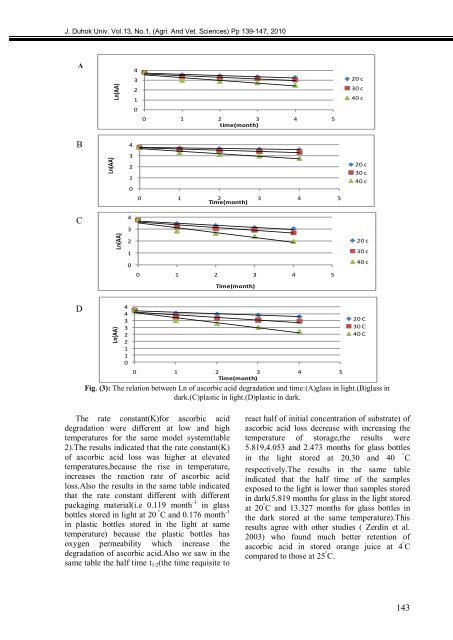The Influence Of Priming Two Cucumber Cultivar Seeds
The Influence Of Priming Two Cucumber Cultivar Seeds
The Influence Of Priming Two Cucumber Cultivar Seeds
You also want an ePaper? Increase the reach of your titles
YUMPU automatically turns print PDFs into web optimized ePapers that Google loves.
J. Duhok Univ. Vol.13, No.1, (Agri. And Vet. Sciences) Pp 139-147, 2010<br />
A<br />
B<br />
C<br />
D<br />
Ln(AA)<br />
Ln(AA)<br />
Ln(AA)<br />
Ln(AA)<br />
4<br />
4<br />
3<br />
3<br />
2<br />
2<br />
1<br />
1<br />
0<br />
4<br />
3<br />
2<br />
1<br />
0<br />
4<br />
3<br />
2<br />
1<br />
0<br />
4<br />
3<br />
2<br />
1<br />
0<br />
0 1 2 3 4 5<br />
time(month)<br />
0 1 2 3 4 5<br />
Time(month)<br />
0 1 2 3 4 5<br />
Time(month)<br />
0 1 2 3 4 5<br />
Time(month)<br />
20 c<br />
30 c<br />
40 c<br />
20 c<br />
30 c<br />
40 c<br />
20 c<br />
30 c<br />
40 c<br />
20 C<br />
30 C<br />
40 C<br />
Fig. (3): <strong>The</strong> relation between Ln of ascorbic acid degradation and time:(A)glass in light.(B)glass in<br />
dark.(C)plastic in light.(D)plastic in dark.<br />
<strong>The</strong> rate constant(K)for ascorbic acid<br />
degradation were different at low and high<br />
temperatures for the same model system(table<br />
2).<strong>The</strong> results indicated that the rate constant(K)<br />
of ascorbic acid loss was higher at elevated<br />
temperatures,because the rise in temperature,<br />
increases the reaction rate of ascorbic acid<br />
loss.Also the results in the same table indicated<br />
that the rate constant different with different<br />
packaging material(i.e 0.119 month -1 in glass<br />
bottles stored in light at 20 ° C and 0.176 month -1<br />
in plastic bottles stored in the light at same<br />
temperature) because the plastic bottles has<br />
oxygen permeability which increase the<br />
degradation of ascorbic acid.Also we saw in the<br />
same table the half time t1/2(the time requisite to<br />
react half of initial concentration of substrate) of<br />
ascorbic acid loss decrease with increasing the<br />
temperature of storage,the results were<br />
5.819,4.053 and 2.473 months for glass bottles<br />
°<br />
in the light stored at 20,30 and 40 C<br />
respectively.<strong>The</strong> results in the same table<br />
indicated that the half time of the samples<br />
exposed to the light is lower than samples stored<br />
in dark(5.819 months for glass in the light stored<br />
at 20 ° C and 13.327 months for glass bottles in<br />
the dark stored at the same temperature).This<br />
results agree with other studies ( Zerdin et al.<br />
2003) who found much better retention of<br />
ascorbic acid in stored orange juice at 4 ° C<br />
compared to those at 25 ° C.<br />
943



